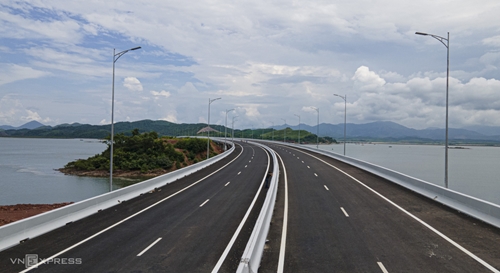Mong Cai city is located in the Northern coastal region, on the bank of the Ka Long River, about 150 km from Ha Long city, Quang Ninh province. Mong Cai shares both sea and land border with China.
Over the past two years, the operation of the Ha Long - Van Don - Mong Cai expressway, together with the Hanoi - Hai Phong expressway, has facilitated the travel to Mong Cai. It takes just three hours and a half to travel from the capital city to Mong Cai.
Below is a suggested 48-hour journey exploring Mong Cai - Tra Co.
First day
Visitors should depart from Hanoi at around 5:30 a.m. The main expressway to Mong Cai is wide and beautiful, especially the Van Don - Mong Cai section, and the scenery on both sides of the road is green and peaceful, more beautiful at dawn and dusk.
    |
 |
|
A view of Van Don - Mong Cai Expressway |
“Remember to stop at the end of Hai Phong or Van Don expressways because there is no stop-over on the entire route to Mong Cai,” advised Hai Minh, a tourist from Hanoi.
First-time visitors to Mong Cai should not miss check-in at Mong Cai International Border Gate where land border marker 1369 stands.
In the city, visitors are advised to try vermicelli or noodles with cu ky, a kind of crabs at restaurants on Tran Quoc Toan or Ly Tu Trong streets.
Mong Cai market and night market are places for exploration of the day. Mong Cai market is one of the largest markets in Quang Ninh with a variety of goods, mainly Chinese goods and Vietnamese exports to China. Popular items include clothes, fabrics, electronics, household goods, and confectionery. Meanwhile, the night market is an area near the central market. It opens from 5 p.m. to 11 p.m. Goods are mainly souvenirs and food. There are also music and entertainment activities.
    |
 |
|
The market in the center of Mong Cai city |
Dinner is available at the night market or restaurants in the city with typical dishes, such as seafood, roasted duck, roasted meat, beef hotpot or other Chinese food.
Prices for large, 3-4 star hotels in the city, such as Majestic, Hung Vuong, Bien Bac, and Hong Van Grand, are reasonable, ranging from VND 600,000 to VND 1.2 million per night.
Second day
It’s ideal to contemplate sunrise, go swimming, have breakfast and savor coffee at Tra Co beach, which is about 15-20-minute drive from the center of Mong Cai city. Visitors can stay overnight in Tra Co if they love enjoying the sea air.
Hai Minh noted that in Tra Co, there are not large hotels, except for Dong Bac Hotel located near Sa Vi Cape. Local motels or small hotels have basic amenities.
Must-be check-in place is Sa Vi Cape, the starting point of the S shape on the map of Vietnam with Marker No.0. Other check-in sites there include the three-pine-tree relief engraved with a line of verse “From poplar forest in Tra Co to mangrove forest in Ca Mau,” and a symbol of eight concrete, galvanized poplar trees. Attentively, from Sa Vi Cape, visitors can view sea border marker 1378.
Many seafood restaurants are located along Tra Vi main road in Tra Co, with VND 200,000 to VND 300,000 per person on average. Suggested restaurants are Viet Hoa Seafood, Cuong Loan, Bien Xanh, and Co Duong.
Returning to Mong Cai city, visitors should go to Ngoc Cape and get on a speedboat to Vinh Thuc Island. On the top of Dau Tan Mountain, North of the island, stands a lighthouse built in the style of old French architecture and put into operation in 1962.
If visitors have more time, they can visit Dongxing, Guangxi province, China during the day, using ID card or passport, or Tra Co communal house and Tra Co church.
Source: Vnexpress
Translated by Mai Huong